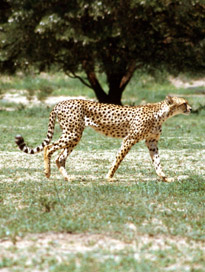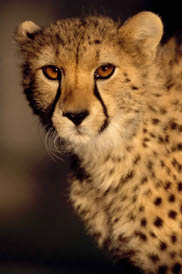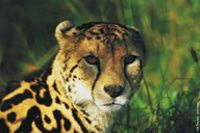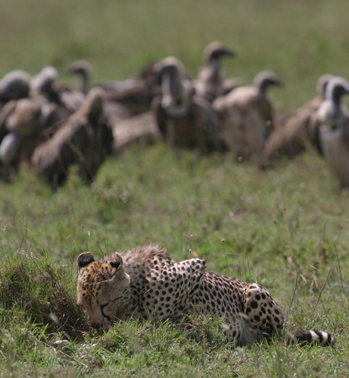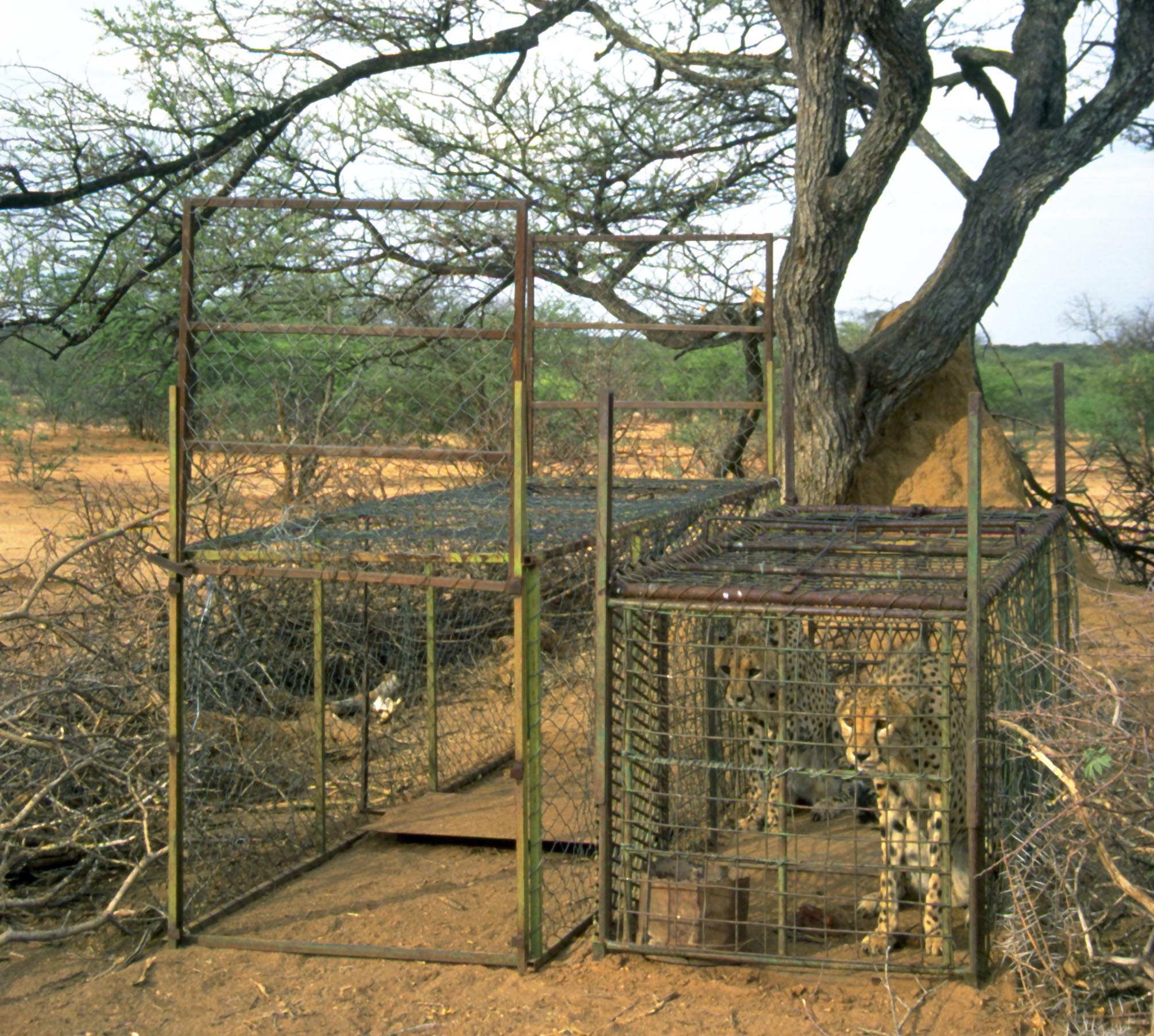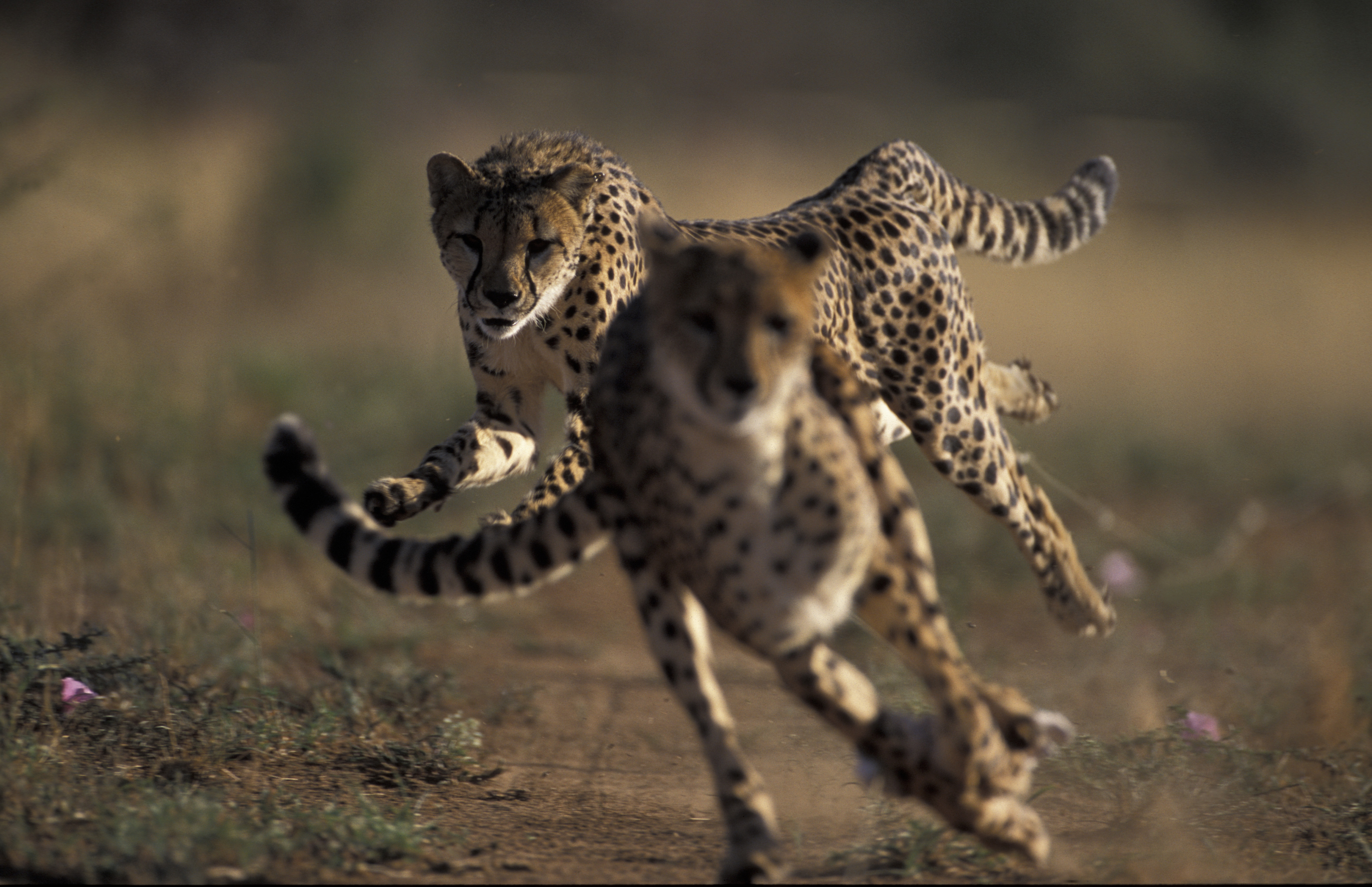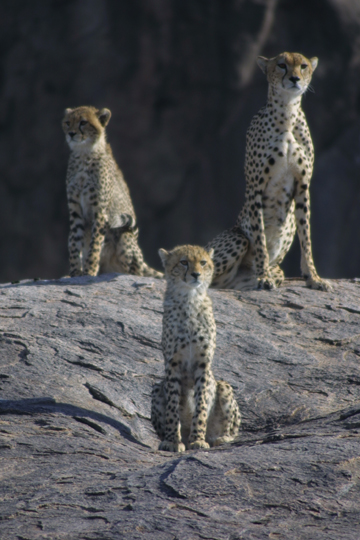|
Background The cheetah was once one of the most widely distributed land animals. Through the course of time, cheetahs migrated over land bridges from North America into China, through Asia, India, Europe, and finally to Africa, settling in its worldwide range as recently as 20,000 years ago. In 1900, approximately 100,000 cheetahs were found in at least 44 countries throughout Africa and Asia. The current free-ranging African populations of cheetahs are found in small, fragmented areas spread in 29 African countries of North Africa, the Sahel, East and southern Africa, and it is estimated that around 15,000 animals remain, representing a decline of nearly 90% over the century. However, current information about the status of the cheetah in many countries, especially countries that have been engaged in long civil wars, is lacking. The information from North and West Africa is particularly limited, and the cheetah's future in these areas is questionable. The remaining strongholds are Kenya and Tanzania in East Africa, and Namibia, Botswana and Zimbabwe in southern Africa. |
|
|
|
The King Cheetah The king cheetah was first noted in Zimbabwe in 1926. In 1927, the naturalist Reginald Innes Pocock declared it a separate species, but reversed this decision in 1939 due to lack of evidence. In 1928, a skin purchased by Lord Rothschild was found to be intermediate in pattern between the king cheetah and spotted cheetah and Abel Chapman considered it to be a colour form of the spotted cheetah. 22 such skins were found between 1926 and 1974. Since 1927, king cheetahs were reported 5 more times in the wild. |
|
Although strangely marked skins had come from Africa, a live king cheetah was not photographed until 1974 in South Africa's Kruger National Park. Cryptozoologists Paul and Lena Bottriell photographed one during an expedition in 1975. They also managed to obtain stuffed specimens. It appeared larger than a spotted cheetah and its fur had a different texture. There was another wild sighting in 1986 - the first for 7 years.
By 1987, 38 specimens had been recorded, many from pelts. Its species status was resolved in 1981 when king cheetahs were born at the De Wildt Cheetah Center in South Africa. In May 1981, two spotted sisters gave birth there and each litter contained one king cheetah. The sisters had both mated with a wild-caught male from the Transvaal area (where King Cheetahs had been recorded). Further King Cheetahs were later born at the Centre. This mutation has been reported in Zimbabwe, Botswana and in the northern part of South Africa's Transvaal province. |
||
| back to top | |
|
An evolutionary history of the cheetah has been constructed by paleontologists from fossils and, more recently, by geneticists using DNA. Present records date carnivores to the Eocene epoch, about fifty million years ago, with the specialised family Felidae evolving in the Miocene about twenty million years ago. In the middle Miocene, early felids began their radiation into other cats with conical canines including the early cheetahs, Miracinonyx and Acinonyx, during the Pliocene and Pleistocene epochs, about eight million to twelve thousand years ago. |
|
|
|
|
|
Cheetahs
are distributed primarily throughout the drier parts of sub-Saharan Africa with vast expanses of land where prey is
abundant. Aside from an estimated one hundred
cheetahs living in Iran, the distribution of the cheetah is now
limited to Africa. In Namibia, it has been found in a variety of habitats, including
grasslands,
savannahs,
dense vegetation,
and mountainous terrain. Ninety-five percent live on commercial farms.
They are not generally
associated with forest habitats and are absent from the Sudano-Guinean forest
savannah belt of west Africa. However, although cheetahs are most frequently
observed on open grassy plains, they also make extensive use of bush, scrub,
and open woodlands. Observations suggest that cheetahs expend more energy
hunting in open country than in cover. A mosaic of woodland and grassland is
probably preferred. Cheetahs are well adapted to living in arid environments.
They are not obligate drinkers and, in the Kalahari desert, have been estimated
to travel an average of 82 km between drinks of water. They were observed to
satisfy their moisture requirements by drinking the blood or urine of their
prey, or by eating tsama melons. |
||||||||
|
||||||||
|
Males are very sociable and group together for life, usually with the brothers from the same litter; although if a cub is the only male in the litter then two or three lone males may group up, or a lone male may join an existing group. These groups are called coalitions. A coalition is six times more likely to obtain a territory than a lone male, although studies have shown that lone males keep their territories just as long as coalitions - four to four and a half years. Males are very territorial. Females' home ranges can be very large and trying to build a territory around several females' ranges is impossible to defend. Instead, males choose the points at which several of the females' home ranges overlap, creating a much smaller space, which can be properly defended against intruders while maximizing the chance of reproduction. Coalitions will try their utmost to maintain territories in order to find females with which they will mate. The size of the territory also depends on the available resources; depending on the part of Africa, the size of a male's territory can vary greatly from 37 to 160 km2.
|
||||||||
|
Males mark their territory by urinating on objects that stand out, such as trees, logs, or termite mounds. The whole coalition contributes to the scent. Males will attempt to kill any intruders and fights often result in serious injury or death. Unlike males and other felines, females do not establish territories. Instead, the area they live in is termed a home range. These overlap with other females' home ranges; often it will be the sisters from the same litter or a daughter's home range overlapping with her mother's. Females, however, always hunt alone, although once their cubs reach the age of five to six weeks they take them along to show them how it is done. The size of a home range depends entirely on the availability of prey. Cheetahs in African woodlands have ranges as small as 34 km2, while in some parts of Namibia they can reach 1,500 km2. Although there have been no studies, it is expected that the home ranges of females in the Sahara are the largest of all the cheetah populations. |
|
|
||||||
|
|
||||||||
|
||||||||
|
||||||||
|
Over the past few years, the impact of infectious diseases on endangered species has become well known. Cheetahs are known to be very susceptible to several feline diseases, and are possibly more vulnerable to such diseases due to the lack of heterogeneity in the population. In addition, captive populations world-wide have been known to have a high prevalence of unusual diseases that are rare in other species, and these diseases impede the goal of maintaining self-sustaining populations. Although the specific causes of these diseases are not known, the character of these diseases implicate stress as an important underlying factor, and genetic predisposition and diet are possible confounding factors. While it is assumed that these diseases did not historically affect wild populations, there is concern that these diseases may arise in wild animals that are trapped, held in captive facilities and translocated. Additionally, there is concern that cheetahs may transmit or acquire infectious diseases through these actions. Diseases with high incidence are glomerulosclerosis, amyloidosis, helicobacter associated gastritis, veno-occlusive disease of the lever and focal palatine erosion. Lymphoplasmacytic gastritis, glomerulosclerosis, renal amyloidosis and veno-occlusive disease have an unusually high incidence in captive cheetah. There is a group of neurological diseases with lower incidence such as Leukoencephalopathy, Progressive hind-limb paralysis in adult cheetahs, Acute hind limb ataxia in cheetah cubs, Spongiform encephalopathy. |
|
| The earliest record of the cheetah’s long association with humans dates back to the Sumerians, 3,000 BC, where a leashed cheetah, with what appears to be a hood on its head, is depicted on an official seal. It was believed in Egyptian history that the cheetah would quickly carry away the Pharaoh’s spirit to the Afterlife and symbols of cheetahs have been found on many statues and paintings in royal tombs. Cheetahs were used for hunting in Libya during the reign of the pharaohs. Cheetahs were not hunted to obtain food, but for the challenge of sport, known as coursing. In Italy, cheetahs were coursed during the fifth century. Russian princes hunted with cheetahs in the 11th and 12th centuries, and, at the same time, crusaders saw cheetahs being used to hunt gazelles in Syria and Palestine. The best records of cheetahs having been kept by royalty, from Europe to China, are from the 14th, 15th and 16th centuries. Cheetahs also were used for hunting in Russia. Eighteenth and 19th century paintings indicate that the cheetah rivalled dogs in popularity as hunting companions. |
|
© A. Dickman
|
|
During his 49-year reign as an Indian Mogul in the 16th century, Akbar the Great had more than 39,000 cheetahs in total, which were called Khasa or the Imperial Cheetahs, and he kept detailed records of them. However, all the cheetahs kept for hunting and coursing purposes were taken out of the wild from free-ranging populations. Because of this continuous drain on the wild populations, the numbers of cheetahs declined throughout Asia. In the early 1900s, India and Iran began to import cheetahs from Africa for hunting purposes. In Africa, the cheetah was important to many local ethnic groups: the San hunting communities of southern Africa ate cheetah meat for speed; traditional healers used cheetah foot bones for fleet-footedness; and kings wore cheetah skins for dignity. These practices, combined with exportation to other countries, contributed to the beginning of the cheetah's decline in Africa. |
||
|
|
|
Decline in prey, loss of habitat, and indiscriminate trapping and shooting as a livestock predator threaten the survival of the cheetah throughout its range. Intraguild competition from more aggressive predators decrease cheetah survivability in protected game reserves, causing larger numbers of cheetahs to live outside protected areas and therefore coming into conflict with humans. As human populations change the landscape of Africa by increasing the numbers of livestock and fenced game farms throughout the cheetah’s range, addressing this conflict may become the most important factor in their conservation. A further concern is that cheetahs breed poorly in captivity and wild populations have continued to sustain captive ones. Until the 1960s, most cheetahs were imported from East Africa but, as the numbers of cheetahs decreased in this region, Namibia became the major exporter of cheetahs. Today more than 90% of all cheetahs in captivity are descendants of Namibian cheetahs. This additional pressure, together with ineffective captive breeding programmes, further endanger cheetah populations. |
||||||
Viable populations may be found in less than half of the countries where cheetahs still exist. All populations are listed on the Convention on International Trade in Endangered Species of Fauna and Flora (CITES) Appendix I and are classified as Vulnerable or Endangered by The World Conservation Union (IUCN) (CITES 1984, CITES 1992). The largest remaining wild population of cheetahs is found in Namibia. |
||||||||
| a) Deterministic factors | ||||||||
| Habitat alteration | ||||||||
| Because of increasingly fragmentation of habitat resulting from human development, cheetah populations become vulnerable to inbreeding and the loss of genetic diversity. | ||||||||
| Habitat removal | ||||||||
| The fragile semi-arid habitat of cheetah is being degraded and in some places returning to desert. Spreading agriculture, industries, human settlements, mining and infrastructure has altered about 96% of the natural habitat of the I.R. of Iran. Most rural people also raise livestock, which compete with gazelle, urial sheep and wild goat - cheetah's main prey species. | ||||||||
| Prey scarcity | ||||||||
|
Most rural people raise
livestock, which compete with gazelle, urial sheep and wild goat - cheetah's
main prey species. Cheetahs
are killing approximately 8% of the adult Thomson's gazelle population each
year. |
||||||||
|
||||||||
| Human-induced mortality | ||||||||
|
Human predation on cats involves hunting and trapping, legal and
illegal. Trophy hunting, mainly for the big cats, has declined in recent years
because of bans in many countries. Local hunting and trapping of cats is still
widespread because of their predation on livestock and just for sport. All the
spotted cats, big and lesser, have been trapped for their beautiful pelts.
Campaigns against the use of wild furs, and the growing strength of the
Convention on International Trade in Wild Species of Fauna and Flora (CITES)
have checked this onslaught. |
||||||||
|
||||||||
| b) Stochastic factors | ||||||||
| Demographic viability | ||||||||
|
Juvenile mortality in cheetahs is found to be extremely high compared to other large mammals, with approximately 72.2% of litters dying before they emerge from the lair at eight weeks of age. An average of 83.3% of cubs alive at emergence die by adolescence at 14 months of age, thus cheetah cubs are estimated to have only a 4.8% chance of reaching independence at birth. Lion predation is the major source of this mortality, although some cubs die from starvation after they are abandoned by their mothers, or as a result of grass fires and inclement weather. Cheetahs have suffered, and continue to suffer, high levels of removal due to conflict with local farmers, and it is important to understand the demography of this population in order to determine its likely persistence. Examination of cheetahs reported live-trapped or killed by local farmers, combined with subsequent information from radio-telemetry, allow demographic parameters such as sex ratios, age and social structure, litter size, interbirth intervals and survivorship to be estimated for cheetahs on Namibian farmlands. Cub mortality is relatively low, but adult mortality is high, particularly for males, and peaks at 5-6 years of age. Data are known on the demography and reproductive success of cheetahs living on the Serengeti Plains, Tanzania over a 25-year period. Average age at independence is 17.1 months, females give birth to their first litter at approximately 2.4 years old, interbirth interval is 20.1 months, and average litter size at independence is 2.1 cubs. Females who survive to independence live on average 6.2 years while minimum male average longevity is 2.8 years for those born in the study area and 5.3 years for immigrants, with a large proportion of males dispersing out of the Plains population. Females produce on average only 1.7 cubs to independence in their entire lifetime and their average reproductive rates are 0.36 cubs per year or 0.17 litters per year to independence. Variance in lifetime reproductive success in the cheetah is similar to that of other mammals. |
|
© S. Durant ZSL & WCS | ||||||
| Genetic viability | ||||||||
| A potentially critical factor for the long-term persistence of the cheetah is its lack of genetic variation relative to other felids. The genetic structure of the cheetah has received considerable attention over the past years. It has been suggested that the genetic homogeneity could make the species more susceptible to ecological and environmental changes. This has been interpreted in the context of two potential risks, including the expression of recessive deleterious alleles, and increased vulnerability to viral and parasitic epizootics that can affect genetically uniform populations. Given the lack of genetic diversity, monitoring the overall health of cheetah populations is an important component of understanding and promoting long-term viability. | ||||||||
| Obstacles to conservation | ||||||||
| Farmers attitudes toward cheetah removal | ||||||||
| Many indiscriminate removals do seem to occur, as almost sixty percent of the farmers that do not consider cheetahs problematic still remove cheetahs. A logical explanation to this deals with traditional predator control attitudes common worldwide. Predators are often eliminated weather they are perceived as a problem or not. | ||||||||
| Economical needs of the people vs. ecological requirements of the cheetah | ||||||||
| The farmer’s interests are in economical gain, be it through the sale of livestock, or selling game as trophies to foreign hunters. The problem is that the vast majority of Namibia's cheetahs reside on the commercial farmlands, where there is abundant prey-base and a lack of large competitors. | ||||||||
|
Limited knowledge |
||||||||
|
In many areas, especially in the North African region, we have extremely limited knowledge on the status of the cheetah and their prey. |
||||||||
Population StatusIUCN Red List: Vulnerable. The total number of cheetahs in sub-Saharan Africa has been variously estimated at 15,000 (Myers 1975), 25,000 (Frame 1984), and 9,000-12,000 (Kraus and Marker-Kraus 1991), and a wide-ranging survey is in progress to develop a better grasp of the cheetah’s current status. The two largest metapopulations of cheetah are now believed to occur in east Africa (Kenya and Tanzania) and southern Africa (Namibia, Botswana, Zimbabwe and Zambia). Density and abundance vary widely according to environmental conditions, especially the occurrence of suitable prey and other large predators. In the Serengeti Plains ecosystem, cheetahs concentrate seasonally in association with migratory movements of Thomson’s gazelle. Estimating cheetah density is complicated by their unusual social organization. Both solitary male and female adults are semi-nomadic, having large, overlapping home ranges of the order of 800-1,500 km2. Coalitions of males, on the other hand, have been found (in the Serengeti) to defend small territories of the order of 12-36 km2, but up to 150 km2. These territories periodically hold big numbers of Thomson’s gazelle, the favoured prey of female cheetahs, and females were often observed in the males’ territories. The wild cheetah is nearly extinct in Asia. Once widely distributed throughout Asia, the cheetah has suffered a devastating decline of available habitat and prey. A small number (100 – 200 individuals) of Asian cheetahs still survive in small pocketed areas through Iran, and possibly in the boarding areas of Pakistan. Protection StatusCITES Appendix I. An Appendix 1 quota system was established under CITES in 1992 for live animals and trophies, with annual quotas allocated as follows: 150 (Namibia), 50 (Zimbabwe), 5 (Botswana). National legislation: fully protected over most of its range. Hunting prohibited: Angola, Benin, Botswana, Burkina Faso, Cameroon, Central African Republic, Ethiopia, Ghana, Kenya, Malawi, Mali, Mauritania, Mozambique, Namibia, Niger, Nigeria, Rwanda, Senegal, South Africa, Sudan, Tanzania, Togo, Uganda, Zaire. Trophy hunting permitted: Namibia. Zambia, Zimbabwe. No information: Chad, Sudan. |
|
|
|
|
|
Sources Anonymous. 2003. Iran Cheetah Project. Berry, H. H., Bush, M. E., Davidson, B., Forge, O., Fox, B., Grisham, J., Munson, L., Nowell, K., Marker-Kraus, L., Martenson, J. S., Hurlbut, S., Howe, M., Schumann, M., Shille, T., Stander, F., Venzke, K., Wagner, T., Wildt, D. E., Ellis, S., and Seal, U. S. Editors. 1997. Population & Habitat Viability Assessment for the Namibian Cheetah (Acinonyx jubatus) and Lion (Panthera leo) Workshop Report, 11-16 February 1996 Otjiwarongo, Namibia. Bianco F., Bracch P.G. 2001. Captive bred cheetah behaviour, Annali della Facoltà di Medicina Veterinaria 21, 47-60. CCF. 1995. Cheetah survival depends on Namibian ranchers Cheetah Conservation Fund Namibia: http://www.cheetah.org Durant S. M. Cheetahs and Tourism - The Serengeti Cheetah Project Eaton R. L. 1974. Conservation. http://en.wikipedia.org/wiki/Cheetah Jackson P. The status and conservation of wild cats Kelly M.J. et al, 1998. Demography of the Serengeti cheetah population: the first 25 years. Marker L. L. 2002. Aspects of Cheetah (Acinonyx jubatus) Biology, Ecology and Conservation Strategies on Namibian Farmlands. Thesis. Lady Margaret Hall, University of Oxford. Venter L. J. A Review of Diseases in Cheetah, see http://bigfive.jl.co.za/cheetah_diseases.htm |
